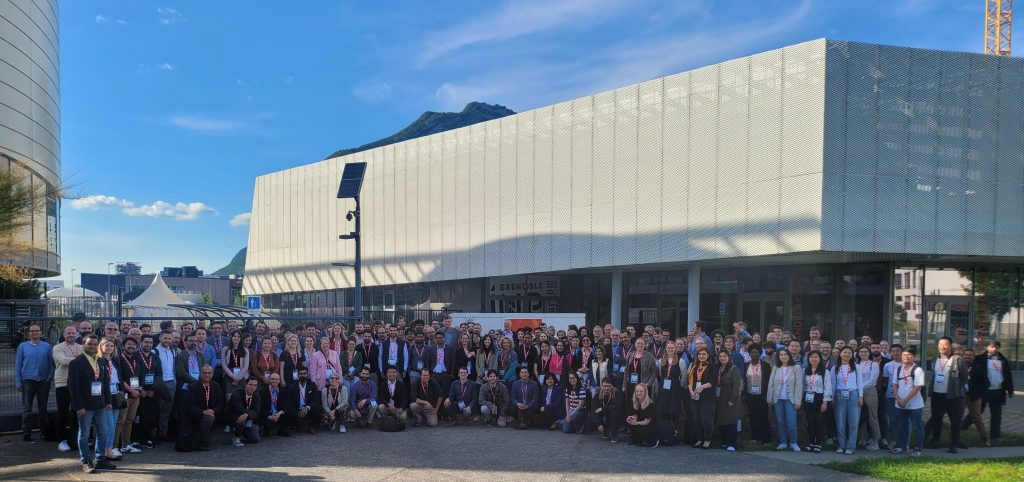At the end of May some 300 people gathered for Battery 2030+ annual conference under the lead of Kristina Edström, Uppsala University, and Philippe Jacques, Emiri. We met at CEA´s beautiful premises in Grenoble. There were presentations from all projects, invited speakers, 96 posters and industry presence as well as members from outside the B 2030+ projects like Cobra and ARI. During two days we learned from each other, gossiped, heard about new research ideas and challenges, tips on how to share data, educate the workforce, on the EU regulations for batteries and many other things.

The greenest batteries on the market
How can we in Europe distinguish ourselves asked Johan Blondell, director at DG RTD, European Commission. He noted that before 2017 battery research was really scattered in Europe, but this has changed with the establishment of EBA and Battery 2030+, now included in the battery partnership. During the last years we have been exposed to political forces with great effects on the energy market in Europe and this has raised a strong will to be more geopolitical independent, he continued. The IRA (Inflation Reduction Act) has attracted many investors from Europe to US. In relation to all this Johan Blondell means that that EU should engage deeper in the development of solid-state and sodium batteries, the latter particularly for large storage applications. He also mentioned the EU Mineral Act for raw materials, and expressed confidence that the Battery 2030+ projects will find new materials, and develop high performance batteries, that later can be manufactured and recycled in a sustainable way in Europe.
– We shall have the greenest and safest batteries on the market, Johan Blondell concluded.
Solving problems with oxygen redox and dendrites
Peter Bruce from Oxford University gave an appreciated speech on “Lithium-rich layered and disordered rocksalt cathodes: the role of oxygen redox”. In the cathode of Li-rich NMC you have more lithium than capacity to remove electrons from the transition metals. So, you have to remove electrons also from the oxygens on the cathode side. But as soon as you start to strip electrons, you get a voltage loss, which is irreversible. This is due to O2 formation trapped in the transitional metal layer, and loosing O2 at the surface of the cathode. To lose O2 at every cycle (although most during the first) causes a voltage loss that cannot be handled by coatings since a coating of molecular oxide voids grows a little bit on every cycling, and O2 becomes harder to reduce in large voids!
For solid state the Li/ceramic electrolyte interface the forming of dendrites is a real problem. They tend to form even in a rather dense electrolyte. They penetrate by dry cracking; although the Li-plating surface seems very smooth, there are always small irregularities from which dendrites can form and metallic lithium start their journey. The propagation contributes to the aging of the battery and furthermore poses a risk for the battery to short circuit. A seemingly obvious answer to this would be to try more dense electrolytes – but then the pressure rises, and hence the risk for micro cracks. It is really a trade-off said Peter Bruce and emphasized the importance of choosing the right material for solid-state electrolytes.

Regulations for a green Europe
Although a rather dry subject Andreas Pfrang’s speech over the battery regulation, and how different kind of batteries are affected by these regulations, draw lot of attention. Andreas Pfrang is active in the Joint Research Centre, a European Commission’s in-house science and knowledge service. Among other things JRC investigates safety, performance, and the degradation of batteries. Regulation of battery production and recycling are derived from the Critical Raw Materials Act, the Net Zero Industry Act, and Eco-design for Sustainable Products Regulation. The overall aims are to make Europe less dependent of imports of materials of strategic importance, and to ensure appropriate production, collection and recycling of batteries in Europe.
Apps up for grabs
To take the human bottle neck out to advance battery science and establish an EU data space for battery research was in focus for both Tejs Vegge, DTU and Simon Clark, Sintef. It is a herculean work to get this in place. It requires, among other things, shared languages for interoperable work flows, common model systems, trust and a willingness to share. The Big-Map project coordinated from DTU have 32 apps in their app store, many with demo videos. Check them out!
Young researchers on the go
A great number of the participants were young researchers, presenting an astonishing 96 posters presenting findings from a variety of aspects of battery research, from the “nitty-gritty” level to battery management systems. The participants could vote for the best poster and the three winners were Frode Håskjold Fagerli, Sintef, Xiliang Lian, Sorbonne and Ali Sad, CEA.
Large investments
Fabrice Stassin, secretary general of BEPA reflected on the Batt4EU partnership. The aim is to strengthen the industrial leadership through stepped-up EU R&I support. We are talking about investments in the range of 925 million Є coming from both the private and public sector. The SRIA (Strategic Research and Innovation Agenda) sets the tone. Fabrice also expressed a need for rules and circumstances making it easier for industry to step in.
Mathieu Morcrette from CNRS gave an overview of the strong battery industry in France with companies like Verkor, Orano, Tiamat and others.
Train the trainers
Planned and already built GWh factories in Europe will need thousands of skilled workers. To train the trainers and to educate young talents in battery science, production and recycling engages Silvia Bodoardo, Polito. Rapid technical advancements call for rapid upskilling; EBA Academy (carried out by Innoenergy) is a vital part here. Silvia Bodoardo also pushes for the making of education centres spread throughout Europe for hands-on training, and a certification system to be in place.
Thanks CEA for a very nice event!

